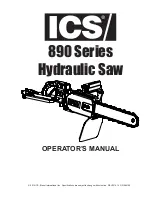
English
16
FIG. 24
FIG. 25
FENCE
TABLE
CROWN MOLDING FLAT ON TABLE AND
AGAINST FENCE
CROWN MOLDING BETWEEN FENCE
AND TABLE
TABLE
FENCE
BOTTOM SIDE
OF MOLDING
TOP SIDE
OF MOLDING
FIG. 26
DW7084
CROWN
MOLDING
FENCE
BEVEL SETTING
TYPE OF CUT
33.9° Left
LEFT SIDE, INSIDE CORNER
1. Top of molding against fence
2. Mitre table set right 31.62°
3. Save left end of cut
33.9° Right
RIGHT SIDE, INSIDE CORNER
1. Top of molding against fence
2. Miter table set right 31.62°
3. Save right end of cut
33.9° Right
LEFT SIDE, OUTSIDE CORNER
1. Top of molding against fence
2. Miter table set at left 31.62°
3. Save left end of cut
33.9° Left
RIGHT SIDE, OUTSIDE CORNER
1. Top of molding against fence
2. Mitre table set right 31.62
3. Save right end of cut°
When setting bevel and miter angles for all compound miters,
remember that:
The angles presented for crown moldings are very precise and
difficult to set exactly. Since they can easily shift slightly and very
few rooms have exactly square corners, all settings should be
tested on scrap molding.
PRETESTING WITH SCRAP MATERIAL IS EXTREMELY
IMPORTANT!
ALTERNATIVE METHOD FOR CUTTING CROWN
MOLDING
Place the molding on the table at an angle between the fence
and the saw table, as shown in Figure 26. Use of the crown
molding fence accessory (DW7084) is highly recommended
because of its degree of accuracy and convenience. The crown
molding fence accessory is available for purchase from your
local dealer.
The advantage to cutting crown molding using this method is
that no bevel cut is required. Minute changes in the miter angle
can be made without affecting the bevel angle. This way, when
corners other than 90° are encountered, the saw can be quickly
and easily adjusted for them. Use the crown molding fence
accessory to maintain the angle at which the molding will be on
the wall.
INSTRUCTIONS FOR CUTTING CROWN MOLDING
ANGLED BETWEEN THE FENCE AND BASE OF THE
SAW FOR ALL CUTS
1. Angle the molding so the bottom of the molding (part which
goes against the wall when installed) is against the fence and
the top of the molding is resting on the base of the saw, as
shown in Figure 26.
2. The angled “flats” on the back of the molding must rest
squarely on the fence and base of the saw.
INSIDE CORNER:
OUTSIDE CORNER:
Left side
Left side
1. Miter right 45
1. Miter left at 45°
2. Save right side of cut
2. Save right side of cut
Right side
Right side
1. Miter left 45°
1. Miter right at 45°
2. Save left side of cut
2. Save left side of cut
Special Cuts
NEVER MAKE ANY CUT UNLESS THE MATERIAL IS
SECURED ON THE TABLE AND AGAINST THE FENCE.
ALUMINUM CUTTING
ALWAYS USE THE APPROPRIATE SAW BLADE MADE
ESPECIALLY FOR CUTTING ALUMINUM. These are available
at your local D
e
WALT retailer or D
e
WALT service center. Certain
workpieces, due to their size, shape or surface finish, may
require the use of a clamp or fixture to prevent movement
during the cut. Position the material so that you will be cutting
the thinnest cross section, as shown in Figure 27. Figure 28
illustrates the wrong way to cut these extrusions. Use a stick
wax cutting lubricant when cutting aluminum. Apply the stick
wax directly to the saw blade before cutting. Never apply stick
wax to a moving blade.
The wax, available at most hardware stores and industrial mill
supply houses, provides proper lubrication and keeps chips
from adhering to the blade.
Be sure to properly secure workpiece.
Refer to
Saw Blades
under
Optional Accessories
for correct
saw blade.
BOWED MATERIAL
When cutting bowed material always position it as shown in
Figure 29 and never like that shown in Figure 30. Positioning
the material incorrectly will cause it to pinch the blade near the
completion of the cut.
CUTTING PLASTIC PIPE OR OTHER ROUND MATERIAL
Plastic pipe can be easily cut with your saw. It should be cut just
like wood and
CLAMPED OR HELD FIRMLY TO THE FENCE
TO KEEP IT FROM ROLLING
. This is extremely important
when making angle cuts.
CUTTING LARGE MATERIAL
Occasionally you will encounter a piece of wood a little too large
to fit beneath the blade guard. If this occurs, simply place your
right thumb on the upper side of the guard and roll the guard
up just enough to clear the workpiece, as shown in Figure 31.
Release the lower blade guard before turning the saw on and
beginning the cut. Avoid doing this as much as possible, but
if need be, the saw will operate properly and make the bigger
cut. NEVER TIE, TAPE, OR OTHERWISE HOLD THE GUARD
















































